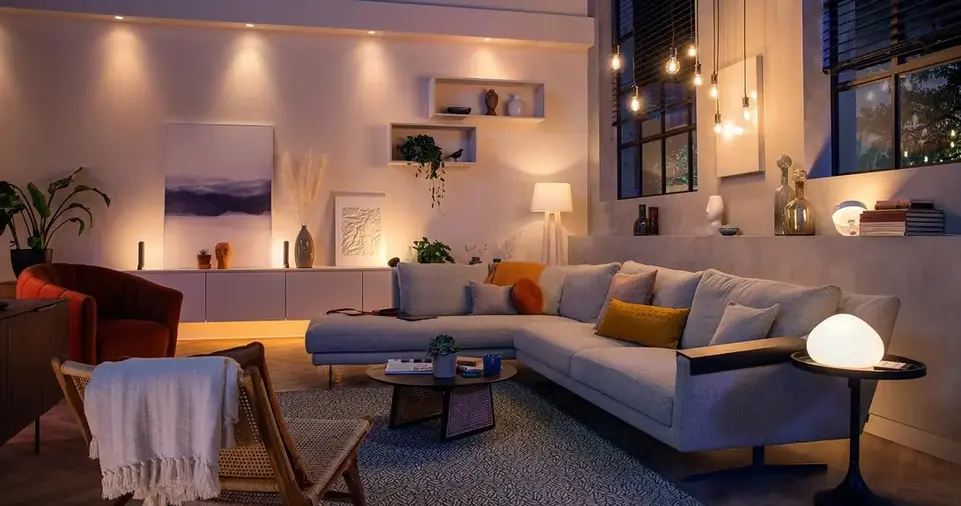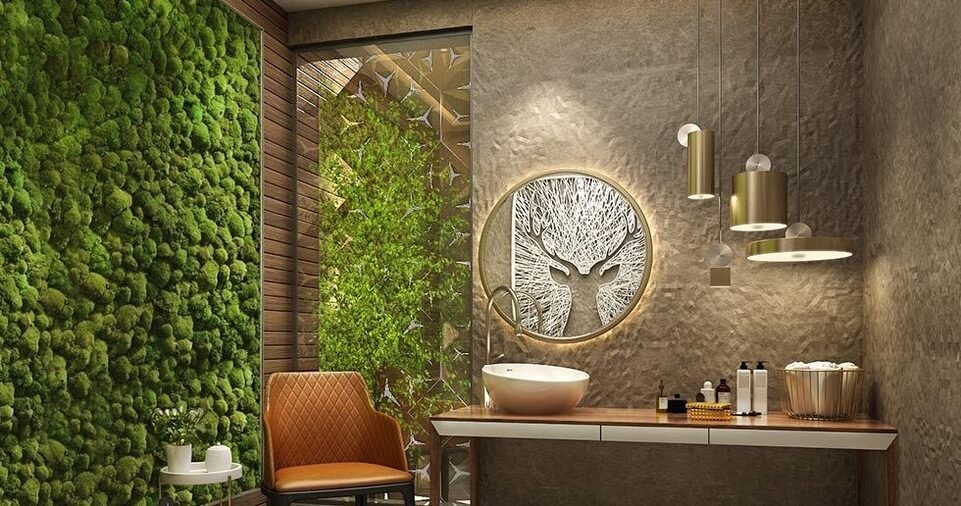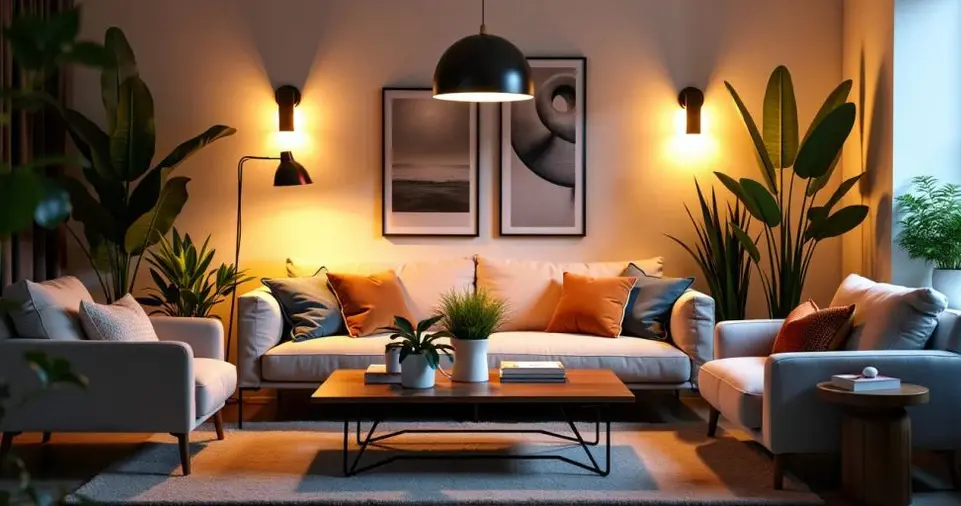Lighting is a crucial element in home design, often underestimated but pivotal in creating a functional and inviting space.
It has the power to set the mood, highlight architectural features, and improve the usability of a room.
Whether you’re planning to renovate your home or simply update your lighting fixtures, understanding how to choose the right lighting for each room is essential.
The ideal lighting strikes a balance between functionality and aesthetics, tailored to the room’s purpose and style.
In this guide, we’ll dive into detailed strategies to help you select the perfect lighting for every room in your home.
From layering light sources to matching lighting styles with decor, this comprehensive guide covers it all.
Let’s illuminate the path to a brighter and more beautiful home.
Understanding the Basics of Home Lighting
Before diving into room-specific tips, it’s important to understand the three main types of lighting:
Ambient Lighting:
This is the primary source of light in a room, providing overall illumination. It sets the foundation and ensures the space is well-lit.
Ceiling fixtures, chandeliers, and recessed lighting are common examples.
Ambient lighting should establish a consistent brightness that creates a welcoming and visually cohesive environment.
Task Lighting:
This type of lighting focuses on specific areas for activities like reading, cooking, or working.
Desk lamps, under-cabinet lights, and vanity lights are excellent task lighting solutions.
Properly positioned task lighting eliminates shadows and enhances productivity, especially in work-heavy zones like kitchens and offices.
Accent Lighting:
Accent lights are decorative and highlight specific features such as artwork, architectural details, or plants.
Wall sconces, spotlights, and LED strips are great options. They add depth and dimension to a room, drawing attention to focal points and enhancing the overall design aesthetic.
Combining these three layers of lighting ensures a well-balanced and functional lighting scheme in every room.
The interplay between these types creates versatility, allowing your space to transform for various occasions and moods.
How to Choose Lighting for the Living Room

The living room is often the heart of the home, a space for relaxation, entertainment, and socializing. The right lighting in this room should be versatile and inviting.
Ambient Lighting for the Living Room
A ceiling fixture such as a chandelier or a flush mount light is a popular choice for ambient lighting.
Recessed lights offer a modern, streamlined look, especially for larger living rooms. For open-concept spaces, consider using dimmable lights to create different moods for various activities.
Layered ambient lighting can help divide a large living area into functional zones, adding depth and cohesiveness.
Task Lighting for Specific Activities
Task lighting is essential for activities such as reading or working. Floor lamps placed next to sofas or armchairs are functional and stylish.
Table lamps on side tables or consoles can also add warmth to the space while serving as task lights.
Adjustable or swing-arm lamps are ideal for versatility, allowing you to direct light where it’s needed most.
Accent Lighting for a Touch of Elegance
Accent lighting can elevate the aesthetic appeal of your living room. Use LED strips to highlight architectural details or place spotlights on artwork.
Wall sconces flanking a fireplace or large mirror can add symmetry and elegance. Consider integrating uplights to emphasize tall ceilings or plants, creating a sophisticated ambiance.
Smart Lighting Options
Integrate smart lighting to control brightness and color with ease.
Smart bulbs or smart plugs can help you create the perfect ambiance for movie nights, parties, or a quiet evening.
Preset scenes and voice commands add convenience and flexibility to your living room setup.
How to Illuminate Your Bedroom
The bedroom is your personal sanctuary, and the lighting should promote relaxation and comfort. Achieving the right balance between functionality and coziness is key.
Warm Ambient Lighting for a Cozy Atmosphere
Use warm, soft lighting as the primary source. A central ceiling fixture, such as a chandelier or flush mount, works well.
Ensure the light isn’t too harsh by opting for frosted covers or dimmable options.
Layered ambient lighting, like combining a ceiling fixture with cove lighting, creates a serene and tranquil environment.
Task Lighting for Bedside and Dressing Areas
Bedside lamps or wall-mounted sconces are perfect for reading or winding down.
Choose fixtures with adjustable brightness or directional light.
For dressing areas, opt for well-lit vanity mirrors or recessed lights around closets.
Ensure task lights have a color rendering index (CRI) of 90 or above for accurate color perception.
Accent Lighting for a Stylish Touch
Accent lighting can add depth to your bedroom decor. Install LED strips under the bed frame or behind headboards for a soft, luxurious glow.
Pendant lights on either side of the bed can also add a modern touch. Layered accent lighting, such as picture lights above artwork, enhances the room’s personality.
Smart Bedroom Lighting
Smart lighting systems can enhance your bedroom’s functionality.
Program lights to gradually dim as bedtime approaches or brighten in the morning to simulate natural sunlight.
Use voice assistants to control lighting without leaving the comfort of your bed.
Kitchen Lighting for Functionality and Style
The kitchen is a bustling workspace where proper lighting is crucial for safety and efficiency. It should combine practicality with aesthetics.
Bright Ambient Lighting for General Use
Use bright, even lighting to illuminate the entire kitchen. Recessed lights or a large ceiling fixture can serve this purpose.
For open kitchens, pendant lights above islands or breakfast bars can provide both ambient light and visual interest.
Ensure light fixtures are easy to clean and resistant to grease and moisture.
Task Lighting for Work Surfaces
Task lighting is essential in areas where you chop, cook, or clean.
Install under-cabinet lights to illuminate countertops, ensuring no shadows fall on your workspace.
Pendant lights can also work well above kitchen islands, providing focused illumination for meal prep and dining.
Accent Lighting for Decor and Depth
Accent lights, such as LED strips above cabinets or inside glass-front cabinets, can add a layer of sophistication.
Toe-kick lighting under lower cabinets creates a floating effect and improves nighttime visibility.
Integrate dimmable LED strips to highlight backsplashes and enhance the kitchen’s design elements.
Energy-Efficient Choices
LED lights are the best choice for kitchens due to their energy efficiency and longevity.
They are available in various color temperatures to suit your preferences.
Consider using daylight-balanced LEDs for a fresh and clean appearance.
ALSO READ: 10 Modern Color Palettes to Transform Your Living Room
Bathroom Lighting for Functionality and Style

Bathrooms require lighting that is both functional and stylish. Proper illumination ensures a safe and comfortable space.
Ambient Lighting for Overall Illumination
Ceiling fixtures or recessed lights work well as ambient lighting.
For smaller bathrooms, a single ceiling light might suffice, while larger spaces may require multiple fixtures.
Layer ambient lighting with wall-mounted fixtures for a more balanced glow.
Task Lighting Around Mirrors
Proper task lighting is essential for grooming tasks like shaving or applying makeup.
Vertical fixtures on either side of the mirror provide even illumination, reducing shadows.
For dual vanities, ensure each mirror has independent task lighting to accommodate individual needs.
Accent Lighting for a Spa-Like Feel
Use accent lighting to create a relaxing, spa-like atmosphere. LED strips under vanities or around bathtubs can add a touch of luxury.
Dimmable fixtures allow you to adjust the brightness for a calming soak or early morning routines.
Moisture-Resistant Fixtures
Choose fixtures rated for damp or wet locations to ensure safety and durability in humid environments. Ensure wiring and bulbs meet safety standards to prevent hazards.
Home Office Lighting for Productivity
The right lighting in your home office can boost productivity and reduce eye strain.
Bright Ambient Lighting for Focus
Overhead lighting should be bright and evenly distributed.
Recessed lights or a central ceiling fixture can provide ample illumination.
Supplement with adjustable wall-mounted fixtures to direct light across the room evenly.
Task Lighting for Work Areas
A desk lamp with adjustable arms and brightness is ideal for focused tasks.
Choose a light with a color temperature of 4000K to 5000K to stay alert and focused.
Anti-glare desk lamps with USB ports add functionality to compact workspaces.
Accent Lighting for Personality
Add personality to your workspace with accent lighting.
Use wall sconces, LED strips, or small decorative lamps to create a comfortable and inspiring environment.
Accent lighting can also highlight bookshelves or framed certificates.
Reduce Glare
Position lights to avoid glare on computer screens.
Opt for fixtures with adjustable angles to direct light where it’s needed most.
Install diffusers or frosted covers to soften harsh lighting.
Dining Room Lighting for Ambiance
Dining room lighting should enhance the ambiance and draw attention to the dining table, the centerpiece of the room.
Chandeliers for a Focal Point
A chandelier above the dining table creates a striking focal point.
Choose a fixture that matches the room’s decor and is proportionate to the table size.
Multi-tiered chandeliers add grandeur, while minimalist designs offer a sleek, modern touch.
Task and Accent Lighting
Add wall sconces or buffet lamps to complement the chandelier.
Dimmer switches are invaluable for adjusting brightness to suit the occasion.
Accent lighting under sideboards or along walls can enhance the room’s architectural features.
Layered Lighting for Versatility
Combine ambient, task, and accent lighting for a versatile and dynamic dining experience.
For example, pair a chandelier with candles or small decorative lights for intimate dinners.
Pendant lights with adjustable height can also add flexibility.
Lighting Hallways and Staircases for Safety and Style
Hallways and staircases often serve as transitional spaces, but they deserve thoughtful lighting for safety and aesthetics.
Ambient Lighting for Visibility
Ceiling fixtures, such as flush mounts or semi-flush mounts, provide general illumination.
For longer hallways, spaced recessed lights ensure even coverage.
Ensure staircases are well-lit to prevent accidents, using wall-mounted fixtures or step lights.
Accent Lighting for Interest
Add interest with accent lighting, such as picture lights for artwork or LED strips along handrails. Illuminate architectural details like archways or niches to create visual depth.
Smart and Motion-Activated Lights
Motion-activated lights are ideal for hallways and staircases, offering convenience and energy efficiency. Program smart lighting to adjust brightness based on the time of day.
Last Words!
By thoughtfully selecting and layering lighting, you can transform every room in your home into a functional and beautiful space.
With the right combination of ambient, task, and accent lighting, tailored to each room’s needs, your home will shine in both form and function.






